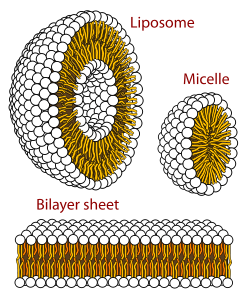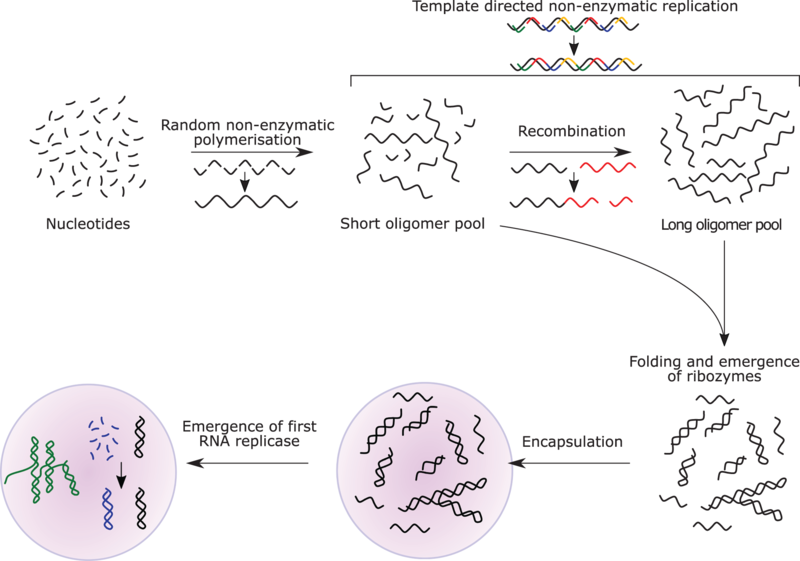15.1: Abiogenesis
( \newcommand{\kernel}{\mathrm{null}\,}\)
Where did life come from?
The study of abiogenesis, the process by which life originates from nonliving matter, is a lively field of science. However, there is no one single accepted model to explain how the first true living organisms appeared on Earth. One proposed idea is panspermia, in which Earth was “seeded” with microorganism delivered by meteorites or comets. The difficulty with panspermia is that does not explain how life originated. It just moves the origin of life from the Earth to somewhere else in space.
 Panspermia: The idea that life originated somewhere in space and was "seeded" on Earth by asteroids or comets.
Panspermia: The idea that life originated somewhere in space and was "seeded" on Earth by asteroids or comets.
As we noted in Chapter 8, finding the first evidence of life on Earth is difficult as rocks dating back to the first billion years of Earth’s history are rare and difficult to find. Because plate tectonics constantly remodels the Earth’s surface, most of the crust dating back to between three and four billion years ago has long been destroyed. However, the evidence we have been able to gather indicates that simple one-celled organisms, such as algae, appeared on Earth about 3.5 billion years ago. More complex one-celled creatures, such as the amoeba, appeared about 2 billion years ago while multicellular organisms began to appear about 1 billion years ago. In contrast, the fossil evidence indicates that anatomically modern homo sapiens evolved between 200,000 and 300,000 years ago while the entirety of human civilization, from the discovery of agriculture to walking on the Moon occurred in the last 10,000 years.
Miller-Urey Experiment
Charles Darwin suggested that life may have begun in a “warm little pond” somewhere. The first attempt to see if organic molecules was conducted in the 1950s by Stanley Miller and supervised by his thesis adviser, Stanley Urey. The Miller-Urey experiment attempted to recreate conditions like those of early Earth. Miller created an apparatus condition water, ammonia, methane, and hydrogen and heated it provide a source of energy. He included an electric spark to simulate lightning. Within a few days, Miller had produced a soup of organic molecules. These included amino acids, the building blocks of proteins. Later evidence from geochemistry indicates that Miller may not have precisely replicated the Earth’s early atmosphere, so he may not have discovered the exact process through which these early organic compounds formed. However, his experiment was a proof of the idea that complex organic molecules can be formed from inorganic molecules through simple chemical reactions.
Since the Miller-Urey experiment, we have detected organic compounds such as amino acids in meteoroids and comets. We have even found them in interstellar clouds. This has led many scientists to suggest that at least some of these organic compounds may have been delivered to Earth from space. One meteorite that fell in Australia contained 12 different amino acids found in Earthly life, although some of them are slightly different in form.
 The Miller-Urey experimental setup.
The Miller-Urey experimental setup.
The First Cells
Wherever the first organic compounds came from, eventually, the first protocells formed as phospholipids came together as membranes. We have found that these phospholipids, when placed in water, natural form membrane-like structures. Lipids found in meteorites have been found to spontaneously form membranes in water. Other protein-like molecules can form clusters of billions of amino acid molecules. These droplets can grow and split into smaller droplets.
_(14601493358).jpg?revision=1&size=bestfit&width=547&height=378) The Murchison Meteorite:
The Murchison Meteorite:
Several amino acids were detected in this meteorite.
https:/commons.wikimedia.org/wiki/File:Carbonaceous_chondrite_(Murchison_Meteorite)_(14601493358).jpg;
 Phospholipids like these naturally form bilayers and membrane-like droplets in water.
Phospholipids like these naturally form bilayers and membrane-like droplets in water.
But these organic compounds are merely the building blocks of life. They are not life itself.
At some point between 3.7 and 4.4 billion years ago, these organic molecules came together to form the first living cells. There is no single, accepted model for abiogenesis, however, likely the most popular one is the RNA World hypothesis. This hypothesis assumes the first self-replicating molecule was RNA. RNA is similar to DNA, but usually forms as single strand instead of the double helix structure of DNA. Today, most organisms use DNA to store genetic information and then use RNA to carry the “blueprint” for building cells out of the nucleus and then use RNA to assemble the amino acids into protein molecules.
 Some viruses use RNA instead of DNA to store their genetic information.
Some viruses use RNA instead of DNA to store their genetic information.
 RNA may have become the first self-replicating molecule.
RNA may have become the first self-replicating molecule.
The RNA world hypothesis suggests that as RNA began to self-replicate, it eventually started to assemble amino acids into the first proteins. Many viruses use RNA instead of DNA to carry genetic information, so this hypothesis suggests that the first organisms were viruses. But how did the first RNA molecules get assembled. One idea is the clay hypothesis is which clay served as a catalyst to build polymers of RNA and the first lipids.
Another hypothesis is the iron-sulfide world. This hypothesis suggests the first self-replicating organic molecules formed using reactions from sulfides of iron or other metals. Life may have first begun in begun in deep hydrothermal vents instead of in shallow pools of “primordial soup.” Today, hydrothermal vents are home to bacteria and other organisms like tube worms that use the energy from these vents. Before the Earth had substantial amounts of oxygen in the atmosphere, it had no ozone layer to protect life from the Sun’s ultraviolet rays. So, it is unlikely that life originated near the surface. The iron-sulfide hypothesis provides a location for life to originate that is shielded from UV-rays and has a source of energy to produce the first self-replicating organisms.
 Perhaps life began at deep sea hydrothermal vents.
Perhaps life began at deep sea hydrothermal vents.
Other hypotheses include hypotheses that the first organic molecules something other than RNA, such as lipids, polycyclic aromatic hydrocarbons (PAH), polyphosphates. In addition, Gold’s deep hot biosphere hypothesis suggests life began several kilometers below the Earth’s surface, using heat from the Interior.
Another hypothesis, called the radioactive beach hypothesis suggests that when the Moon was closer to the Earth, its gravity might have concentrated uranium or other radioactive elements near the high-water mark of early beaches. This energy could have “kicked started” life. Another idea proposed that life originated in fluctuating hydrothermal pools on volcanic islands or proto continents. Some scientists have concluded that cell membranes cannot be formed in salty seawater. During this time before continents, the only dry land on Earth would be volcanic islands. On these islands, rainwater could have formed freshwater ponds where lipids could have formed into protocells.
Finally, it is possible that there were multiple occasions where life began simultaneously from multiple sources, with one ultimately winning out.







